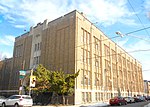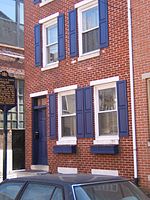Queen Village, Philadelphia

Queen Village is a residential neighborhood of Philadelphia, Pennsylvania that lies along the eastern edge of the city in South Philadelphia. It shares boundaries with Society Hill to the north, Bella Vista to the west and Pennsport to the south. Historically, the area is part of old Southwark, Philadelphia's first suburb, which was incorporated into the city in 1854 and remains the city's oldest residential neighborhood. Street boundaries are the south side of Lombard Street to the north side of Washington Avenue, the Delaware River to 6th Street, encompassing two principal commercial corridors, South Street and Fabric Row on 4th Street. Queen Village was known for its large Irish immigrant population.
Excerpt from the Wikipedia article Queen Village, Philadelphia (License: CC BY-SA 3.0, Authors, Images).Queen Village, Philadelphia
South 4th Street, Philadelphia South Philadelphia
Geographical coordinates (GPS) Address Nearby Places Show on map
Geographical coordinates (GPS)
| Latitude | Longitude |
|---|---|
| N 39.9385 ° | E -75.15 ° |
Address
South 4th Street 770
19147 Philadelphia, South Philadelphia
Pennsylvania, United States
Open on Google Maps








